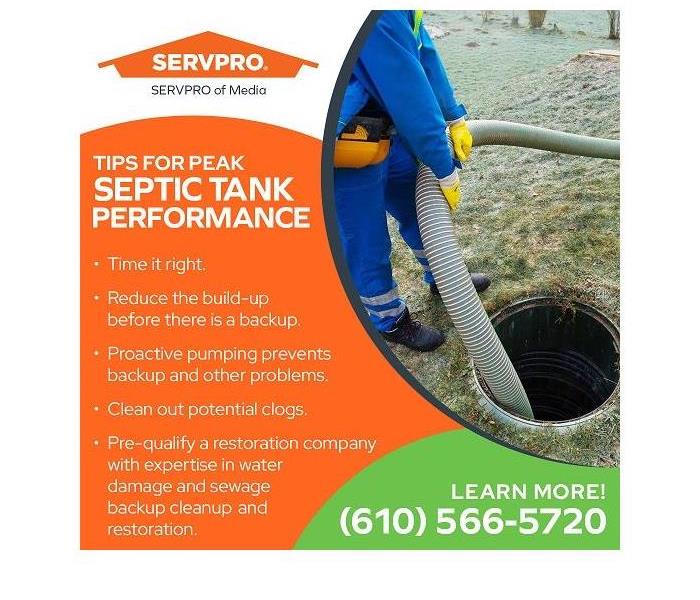The Importance of Having the Sewage System Pumped Before a Sewage Backup Occurs
2/1/2022 (Permalink)
Blog Summary: SERVPRO of Media offers five tips about septic tank pumping that can help homeowners avoid a disastrous sewage backup.
SERVPRO of Media, PA, is the property damage restoration company to call when a sewage backup occurs. The team utilizes industry-leading equipment, training, protective gear, and EPA-approved cleaning and disinfecting products. The trained professional technicians of SERVPRO help to restore the home or business that has suffered a sewage backup to a clean and safe environment.
Septic system longevity depends upon an intentional effort to properly maintain the system. A key component of a solid maintenance program involves having the septic tank pumped at the appropriate time. By scheduling septic pumping according to the rhythm of life in the home, the homeowner can prevent major issues from developing and extend the life of the system. Many residents forget, neglect, or put off maintenance until it is too late. SERVPRO of Media, PA, offers this advice to help homeowners, businesses, or any facility that has a septic system grasp the importance of proper care and maintenance.
Tips for Peak Septic Tank Performance
Tip #1: Time it right.
Many factors influence the frequency of scheduling an appointment with a reputable, bonded, and insured septic system maintenance and repair company. These considerations include:
- The size of the tank
- The number of people living in the home
- Frequency of flushing
- Frequency of baths and length of showers
- What is flushed down the toilet
- What is poured down the drain of the kitchen sink
- Additional guests
- The use of a garbage disposal
If any of these factors are excessive, then the time to pump the septic tank may need to be yearly. Premature pumping has no downside. The septic professional can evaluate any build-up and determine its source. The homeowner can make adjustments that lead to a reduction in the frequency of pumping and that extend the life of the system. While the tank is open, the technician can inspect and clean the filter if one is in use.
Tip #2: Reduce the build-up before there is a backup.
The property owner who procrastinates in pumping out the septic tank will end up with a tank filled with solids. This build-up of solids can lead to issues more costly to resolve than a simple pumping. By following a customized pumping plan, the homeowner or business can avoid the overflow of solids into the leach field. Excessive solids in the tank can cause backups and slow the rate of drainage into the leach field.
Tip #3: Proactive pumping prevents backup and other problems.
Proactive maintenance can help prevent the following issues:
- Backups
- Cracked and leaking pipes
- Slow and insufficient drainage of liquids into the leach field
- Foul odors and strange sounds
A sewage backup is a black water event where the water has been contaminated with urine, raw feces, and toxic pathogens. Professional technicians equipped with appropriate personal protective equipment should be tasked with carrying out the sewage cleanup project.
Tip #4: Clean out potential clogs.
Certain items should never be flushed, and even some products described or marketed as “flushable” should not be flushed down the toilet. Here are some prime examples of potential clogs that, if not removed, can obstruct pipes and restrict the flow of liquid waste into the leach field.
- Cooking grease
- Food scraps
- Paper towels, napkins, or facial tissue (Only toilet paper is engineered to break down when flushed.)
- Feminine hygiene products
- Baby wipes and disinfecting wipes (even if the wipes are classified as “flushable”)
- Pet litter (including brands classified as “flushable”)
- Cotton products and clothing
- Diapers (even “flushable” ones)
- Hair and dental floss
- Bleach (Bleach is not an effective drain opener and can react with other chemicals in the drain, giving off harmful fumes.)
- Toys
The first step is to immediately stop flushing these items down the toilet. The second step is to have the septic tank pumped to remove clogs. It does not take many wipes, tissues, or paper towels to disrupt the septic system. Clumped pet litter can gum up pipes and gum up the leach field.
Tip #5: Pre-qualify a restoration company with expertise in water damage and sewage backup cleanup and restoration.
A sewage backup is a highly toxic water damage disaster that requires a special skill set, experience, the proper equipment, commercial-grade personal protective equipment, and advanced cleaning techniques. Specialized cleaners, disinfectants, sanitizers, and deodorizers must be carefully utilized to achieve a clean, safe, and palatable environment.
SERVPRO of Media is able to meet the challenges of a sewage backup. Water removal, drying, dehumidification, cleaning, and restoration services are provided by experienced, highly trained, and certified technicians who work carefully to restore the disaster site to a clean and safe environment. Crews are available 24/7, 365 days a year, including holidays, and typically arrive at the client’s home in about an hour. When a sewage backup is involved, this quick response is vital to prevent advanced secondary damage and hasten the recovery process.
To learn more about SERVPRO of Media’s sewage and water damage cleanup services, contact the office by email at office@SERVPROmedia.com. The team can also be reached by calling (610) 566-5720.






 24/7 Emergency Service
24/7 Emergency Service
